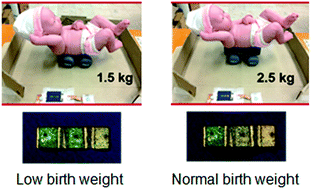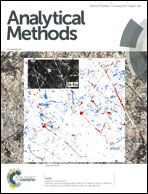A balance-in-a-box: an integrated paper-based weighing balance for infant birth weight determination†
Abstract
The birth weight of babies is generally used as a health state indicator but is not often recorded in resource-poor settings due to limited access to medical clinics. In this work we develop a low-cost and lightweight “balance-in-a-box” that could allow remote communities to have access to a weighing balance. The “balance-in-a-box” is a cardboard mailing box which is reconstructed to form the balance tray, with a novel piezoresistive pressure sensor underneath, a paper-based readout system and battery integrated with copper tape to form an electrical circuit. The readout system comprises multiple segments of electrochromic Prussian blue/polyaniline on conductive gold nanoparticle films connected by graphite resistive separators. The color of each segment is voltage dependent and is directly correlated to the weight applied to the pressure sensor. It is shown that by varying the properties of the readout system (total resistance, individual resistance values of the graphite separators and number of gold nanoparticle segments) that it is possible to tune the critical weight values in which the gold nanoparticle segments change color. Overall, this work demonstrates that babies can be classified as very low birth weight (<1.5 kg), low birth weight (1.5 to 2.5 kg) or healthy (>2.5 kg) using a simple, integrated paper-based system that can be deployed to resource-poor settings where babies are at greatest risk of being underweight and requiring health care treatment.


 Please wait while we load your content...
Please wait while we load your content...